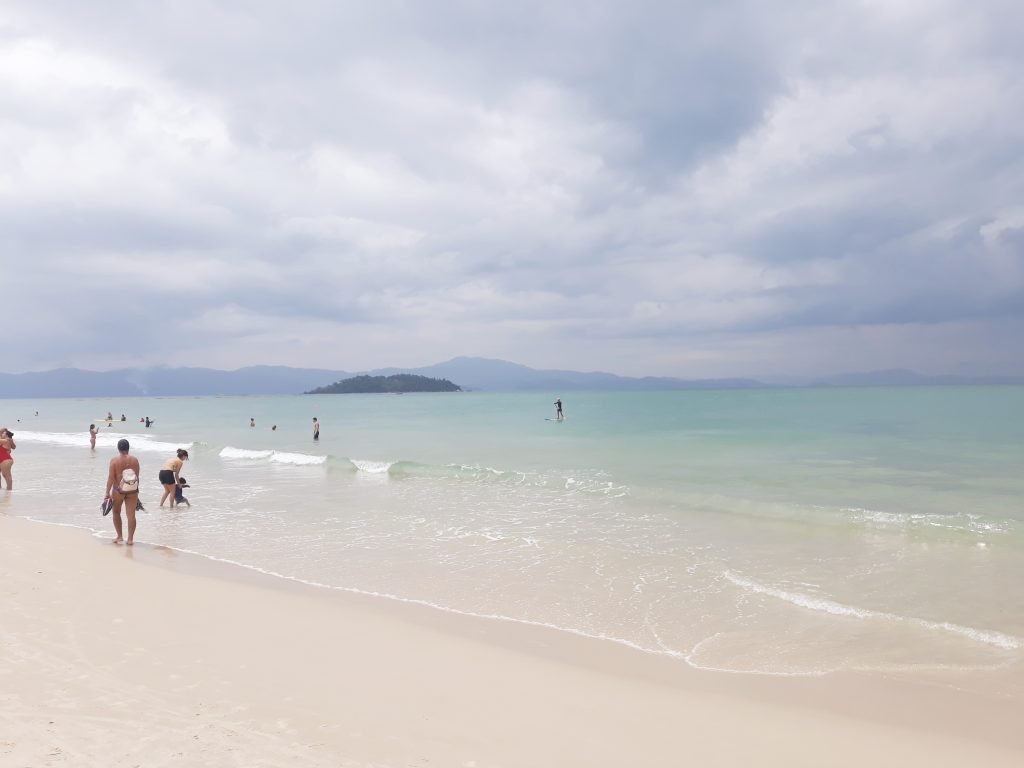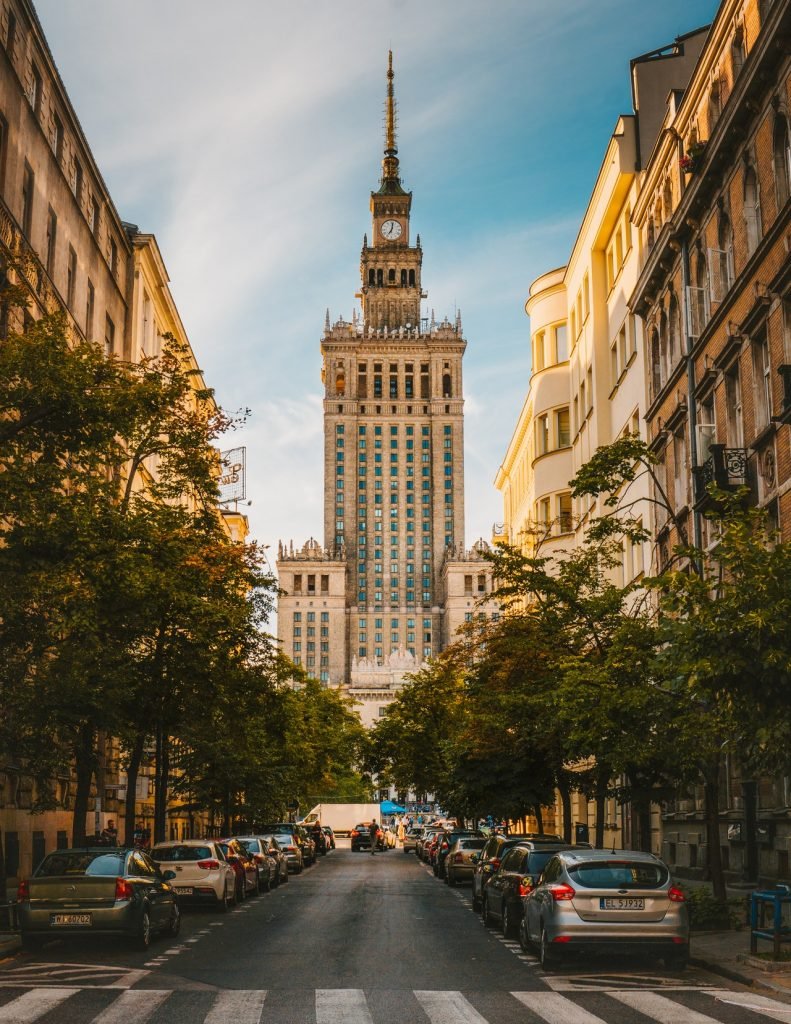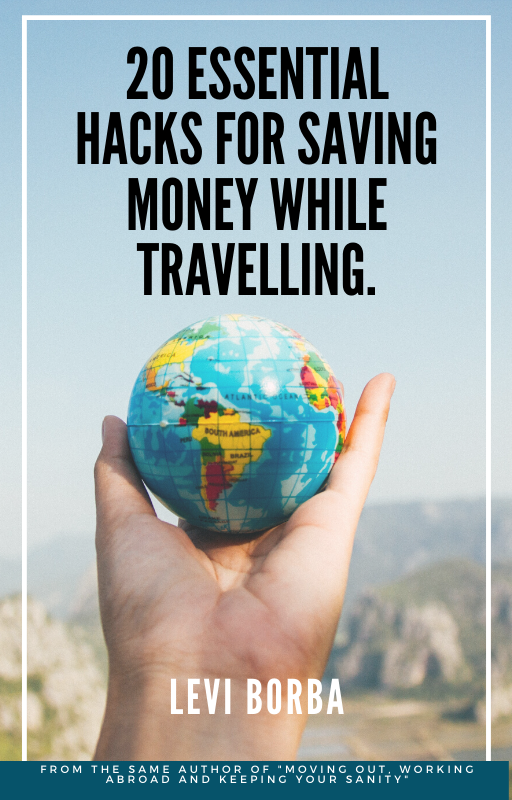Croatia, Bulgaria, Albania, Montenegro. Four countries, four completely different realities for expats.
One has multiple and flexible paths for EU residency. Another lets you retire comfortably on just $1,035 a month, and a third has unbelievable real estate options.
The twist? The country everyone assumes is the safe bet is not always the smart one.
Which of these four actually protects your money and your lifestyle? You’ve probably heard reasons to move to Croatia or Bulgaria, but have you actually checked what Montenegro and Albania are offering right now?
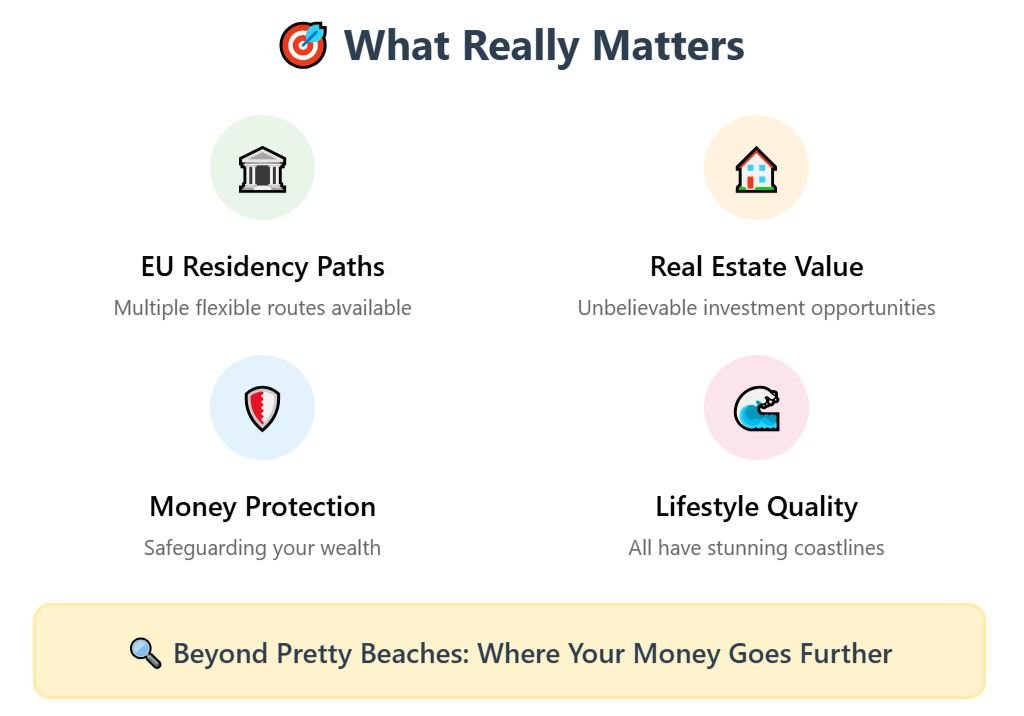
This isn’t about which beach looks prettier — all four have breathtaking coastlines. It’s about where your money and residency actually go further. Different risks, different rules, different rewards.
I’ve spent years helping hundreds of non-EU expats figure out the smartest place to live in Europe, and today, I’ll rank them in each aspect. For this comparison, I chose four cities from these four countries that have similar sizes so we can compare apples to apples.
Additionally, all these cities raised huge interest from our readers:
- In Albania, Durrës.
- In Bulgaria, Burgas.
- In Croatia, Split,
- and in Montenegro, Podgorica.
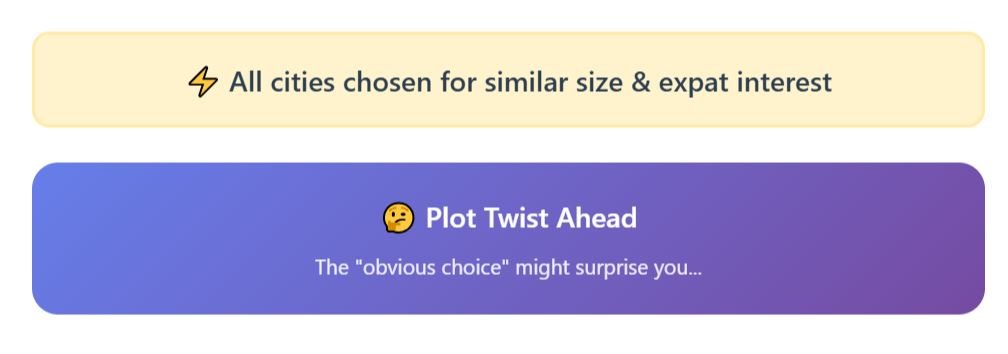
Healthcare Infrastructure
Now, let’s go for the first factor, which is literally something your life depends on: healthcare infrastructure.
Healthcare is often where a cheap move abroad turns into an expensive mistake. For retirees, the risk isn’t only financial — it’s whether you can actually get proper treatment without long waits or outdated systems.
Across these four countries, the differences are sharp. Croatia takes the lead — the country has a private hospital accredited with the JCI Gold Seal of Approval, an international standard for medical quality. It is located in the capital, Zagreb.
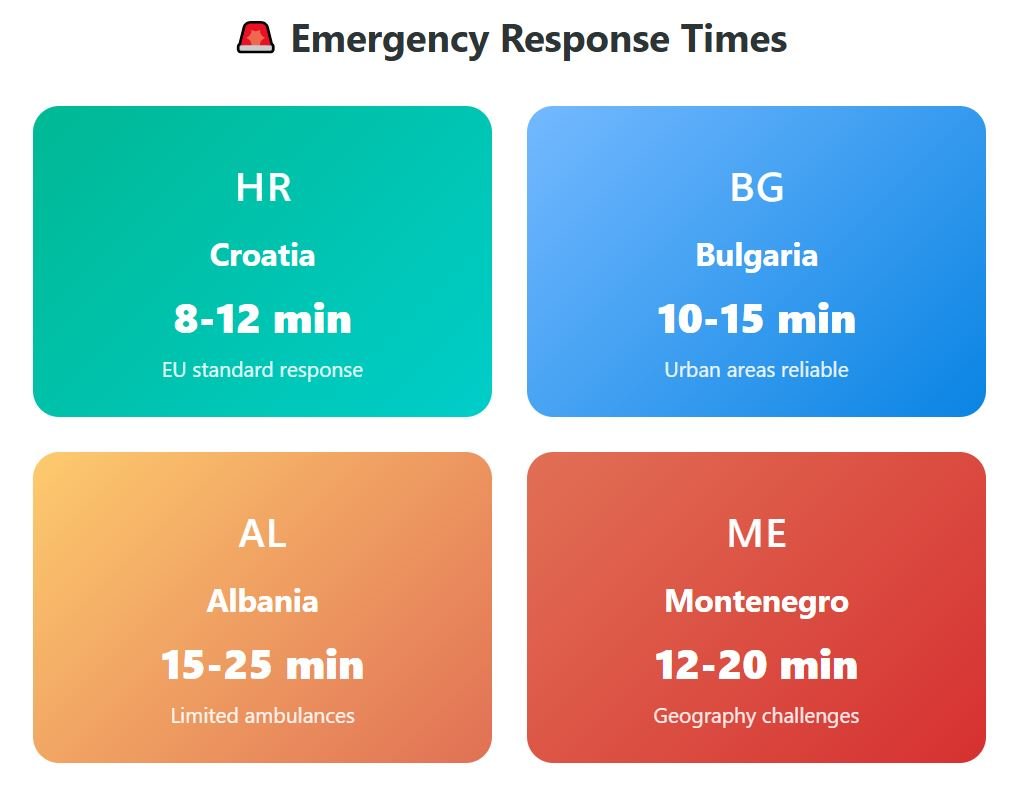
Split itself also has multiple renowned institutions. For expats, this means appointments in days (not months), English-speaking staff, and outcomes tracked to global benchmarks. A Croatian told us this about healthcare: “Dermatology, dental, and eye surgery are all a big thing in Croatia as medical tourism because our private clinics are really good and not that expensive compared to the rest of the EU, and if you compare to American prices, then we are really cheap!”
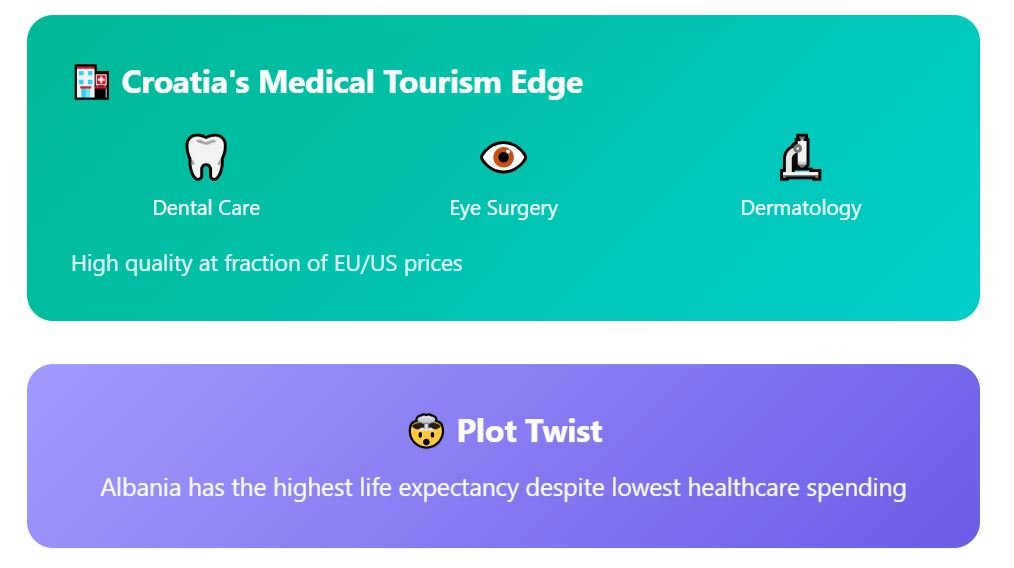
Albania, by contrast, spends just $856 per person annually on healthcare — among the lowest in Europe. Yes, groceries and housing in Vlorë are cheap, but the real cost shows up in medical coverage.
International insurance averages between $5,000 and $10,000 per year, and without it, you’re exposed. Montenegro is even stricter — if you get residency through property ownership — the route most retirees use — you are excluded from the national healthcare system. Public hospitals charge foreigners full price, so in practice, you cannot avoid buying long-term international coverage that will cost you a few thousand dollars per year.
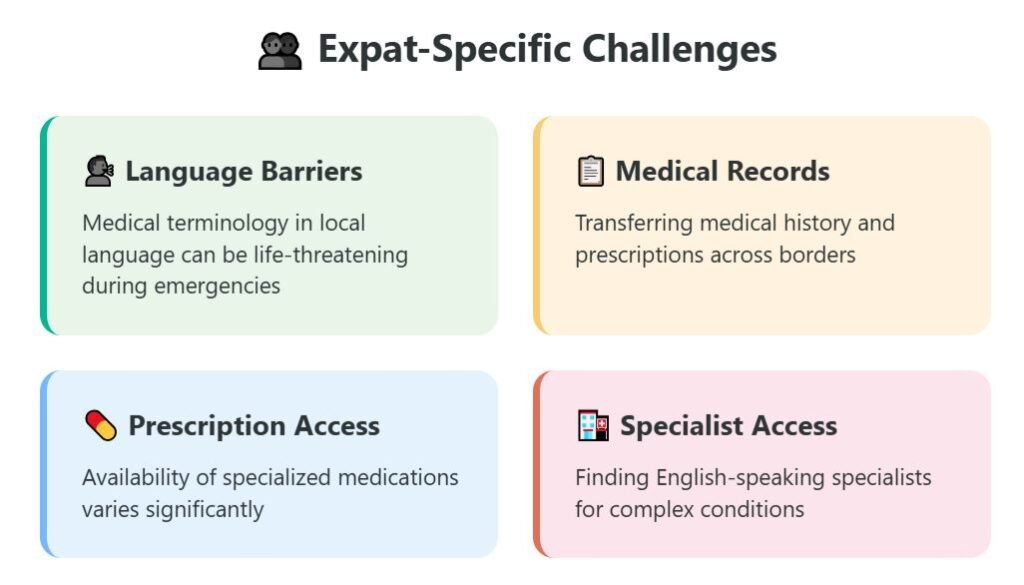
Bulgaria sits in between — it doesn’t have an internationally ranked hospital in Varna or Burgas, but it has decent and affordable institutions. While private care is still the safe route, there’s less uncertainty than in Albania. For long-term expats, EU-backed consistency is a meaningful advantage.
Here’s one surprise: Albania — despite its low spending — has the highest life expectancy of the four. That’s more about lifestyle than medicine: more walking, fresher food, and family support.
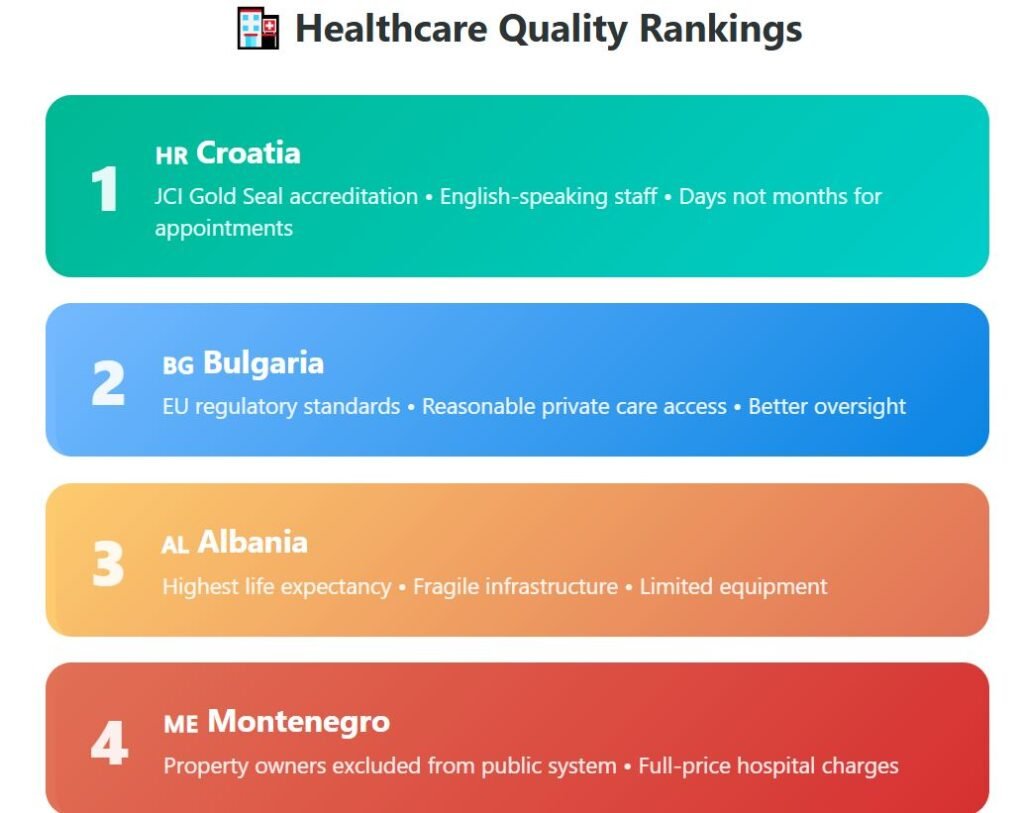
Ranking the healthcare systems: 1st — Croatia — a JCI-accredited hospital and shorter waits. 2nd — Bulgaria — EU stability, reasonable access to private care. 3rd — Albania — high life expectancy overall, but more fragile infrastructure. 4th — Montenegro — residency rules exclude you from public care.
Healthcare tells us who’s protected in moments of crisis, but life abroad isn’t judged only in emergencies. And the real comparisons between these four countries start to look very different once we measure the next factor.

Quality of Life
Living abroad isn’t just about beaches — it’s about whether day-to-day life feels stable, safe, and connected. A useful indicator is the Human Development Index (HDI) — it might not be perfect (because all indicators are simplifications), but it is a good approximation to measure quality of life.
Croatia leads here — its HDI rank is 39th globally, backed by a per capita income above $21,000. In Split, this translates into reliable infrastructure, dependable public services, and safe streets.
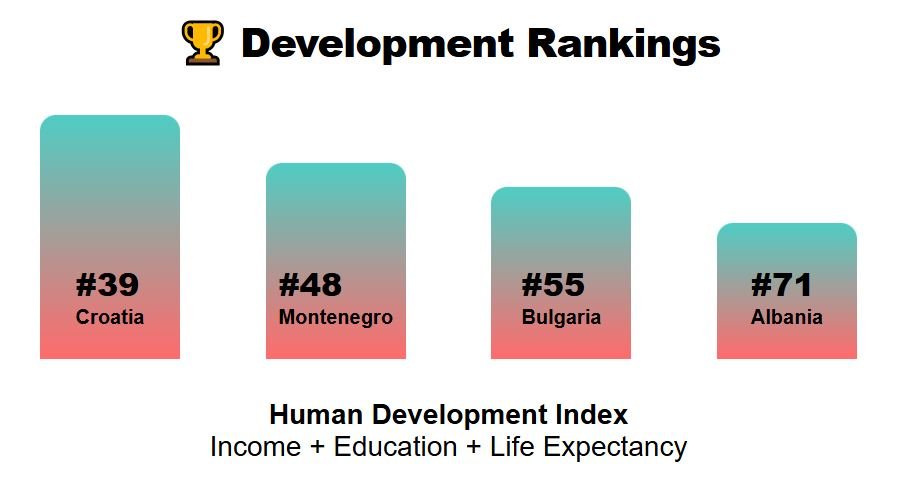
Average life expectancy is quite high, with low crime (a Numbeo crime index of just 26, among the safest in Europe), reinforcing a sense of resilience and predictability in daily life. Albania is the outlier — its HDI ranks at just 71st globally, the lowest of the four. Its income per capita is only $7,570, also the lowest among the group, yet Albanians have the highest life expectancy.
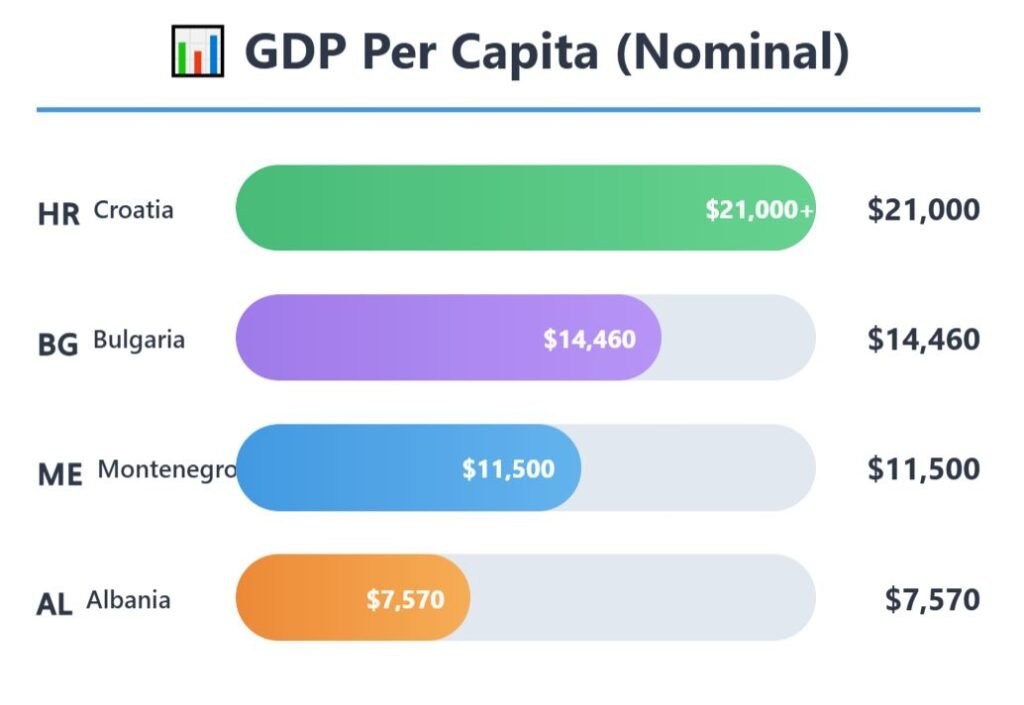
Safety is acceptable, though not as strong as Croatia. Albania’s crime index stands around 46, meaning petty theft is a bigger issue, even if violent crime remains rare. One concern about Vlorë is that, since its economy relies heavily on tourism, during winter it might be a ghost city — but that is not really the case.
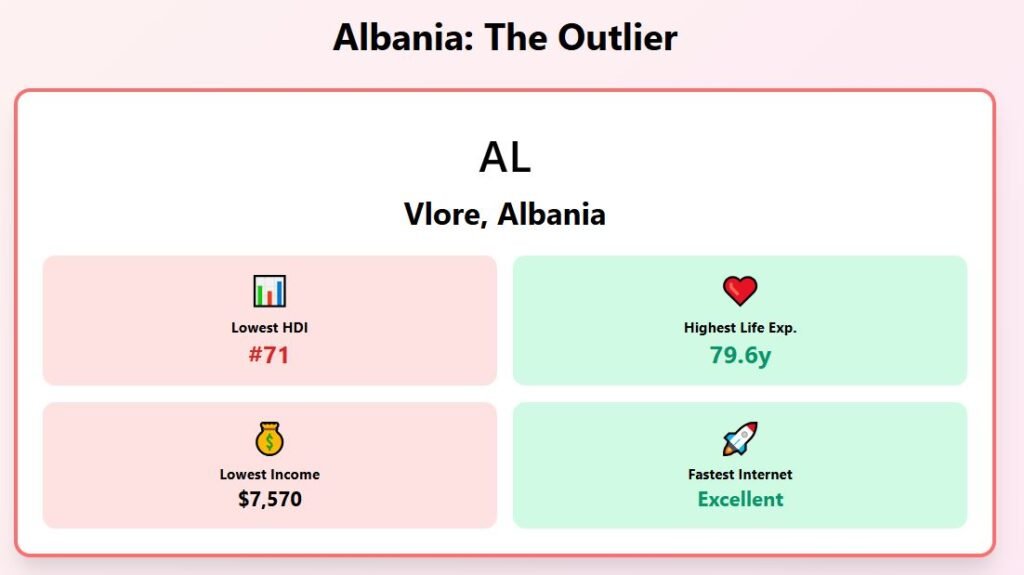
This is what a local resident told us:
“Vlorë is the third biggest city in the country. Apart from summer-tourism-specific businesses, most other things will keep running. It’ll just be less frequent and less crowded. Luckily, the restaurants closed for the winter are the ones likeliest to be tourist traps.”
A cool thing about Albania is that, if you are American, you are really welcome there. It is one of the eight countries in Europe where Americans are most welcome.
Montenegro holds an HDI rank of 48th, with income per capita around $11,500. Podgorica, its inland capital, is modernizing, but life expectancy is 77.1 years, below both Croatia and Albania.
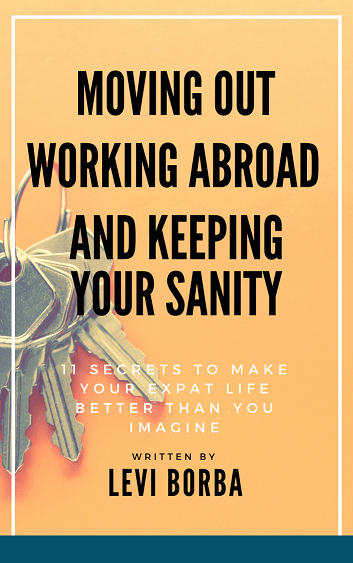
Safety is decent, with a crime index around 38 — worse than Croatia, but still better than Albania. You gain predictability from a capital less dependent on seasonal tourism, but overall development levels remain modest. Bulgaria comes next.
Income per capita there is about $14,460, above Montenegro but well behind Croatia. Same for HDI. Life expectancy is 75.6 years, slightly lower than its neighbors.
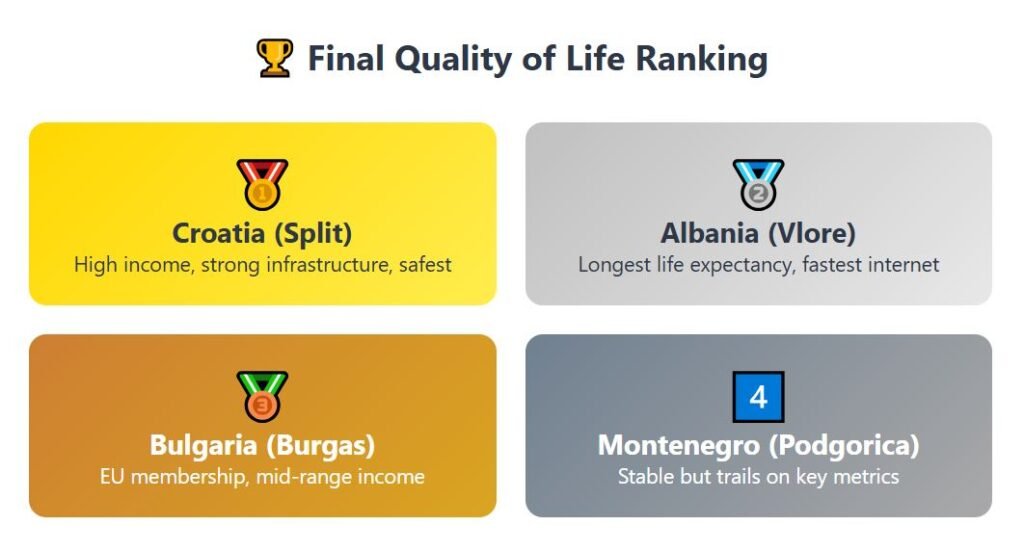
Ranking quality of life: 1. Croatia (Split) — high income, strong infrastructure, very safe (lowest crime). 2. Albania (Vlorë) — their HDI is the lowest, in good part because their income is the lowest, but the longest life expectancy and lower costs (more about this soon) make it attractive. 3. Bulgaria (Burgas) — EU membership, mid-range income, moderate crime. 4. Montenegro (Podgorica) — stable, but trails on income, development, and health.
PS: I have some really good news: FREE FOR A LIMITED TIME: Grab your Expat Wealth & Lifestyle Compass ($108 value) today! Includes our 74-page guide of Affordable European Cities, our Zero-Tax countries report, and our expat checklist. http://patreon.com/The_ExpatJoin us here before this offer ends.
The Cost of Living
Cost of living is often the decisive factor for retirees and long-term expats, and across these four locations, the gap adds up to thousands of dollars per year.
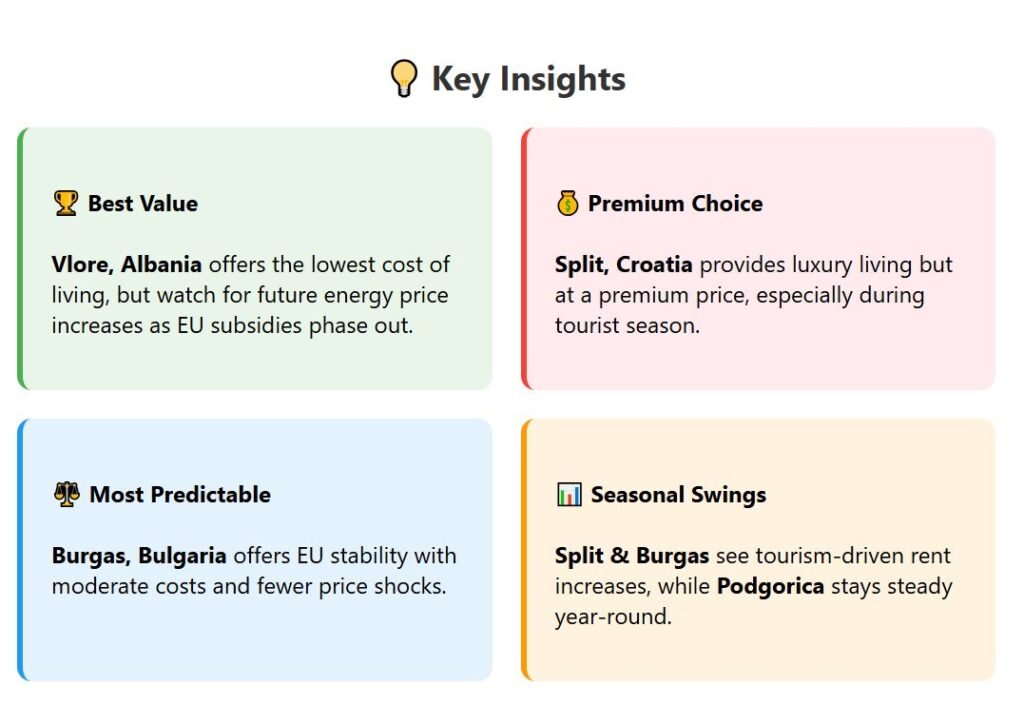
Take Split, Croatia. Croatia’s income per capita is above $21,000, far ahead of its Balkan neighbors, and the costs reflect such higher income. For a single person, a comfortable monthly budget excluding rent is about $1,200 in Split.
Housing pushes the total up sharply, but more about that in a few minutes. Split delivers strong lifestyle benefits, but financially it sits in the luxury bracket. This is what a local told us about life there: “I would say that Split is an amazing place to live if you are not in the town center in the summer period when it is too crowded. We have really nice weather and so many sunny days. We still wear short sleeves during the day! I would say the main downsides are expensive rents and groceries, which are even more expensive than in Italy or Germany.”
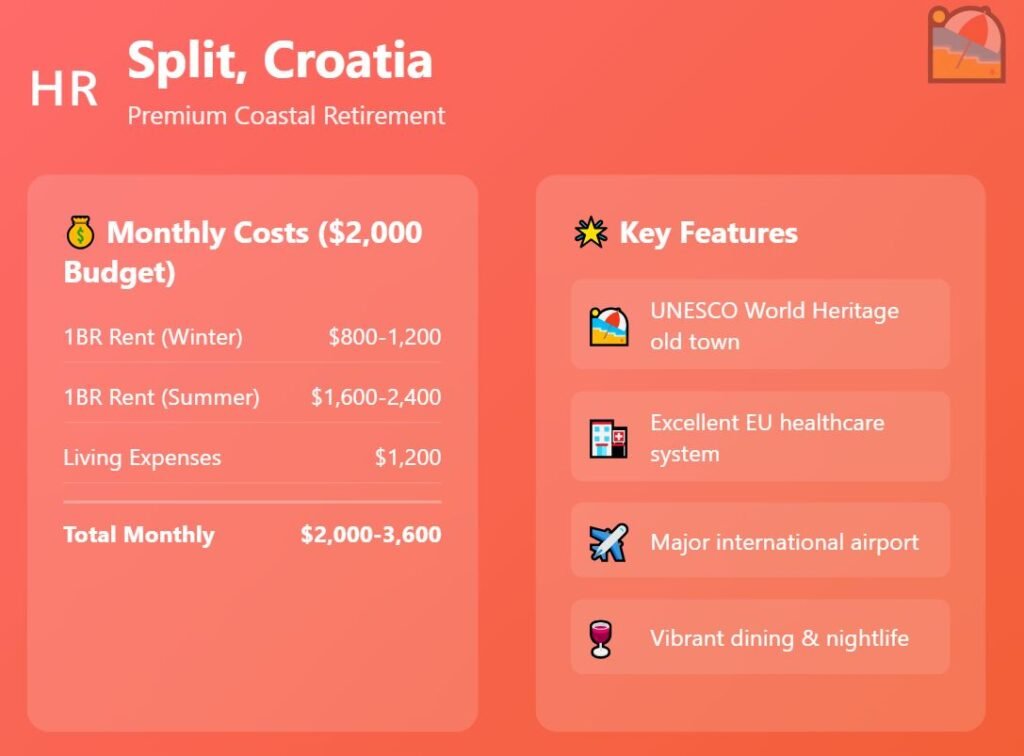
Vlorë, Albania, is the opposite. One-bedroom rentals range from about $428 to $642 per month — less than half of what many expats pay in Croatia. Day-to-day costs are also much lower. Albania’s gross national income per capita is just $7,570, and that filters through to consumer prices. On $2,000 per month, retirees in Vlorë can usually cover essentials and still set aside meaningful discretionary spending for eating out, short trips, or supplemental health coverage. One key caveat in Albania is energy.
Today’s bills are cushioned by subsidies, but as Albania advances toward EU accession, those subsidies will be phased out. Podgorica, Montenegro, has a different profile. One-bedroom rents typically range from $650 to $900 — higher than Vlorë but below Split’s peak rates. Groceries and services are not expensive, anchored by local wage levels. The advantage is stability: as an inland capital, Podgorica avoids the severe seasonal surges that destabilize coastal markets.
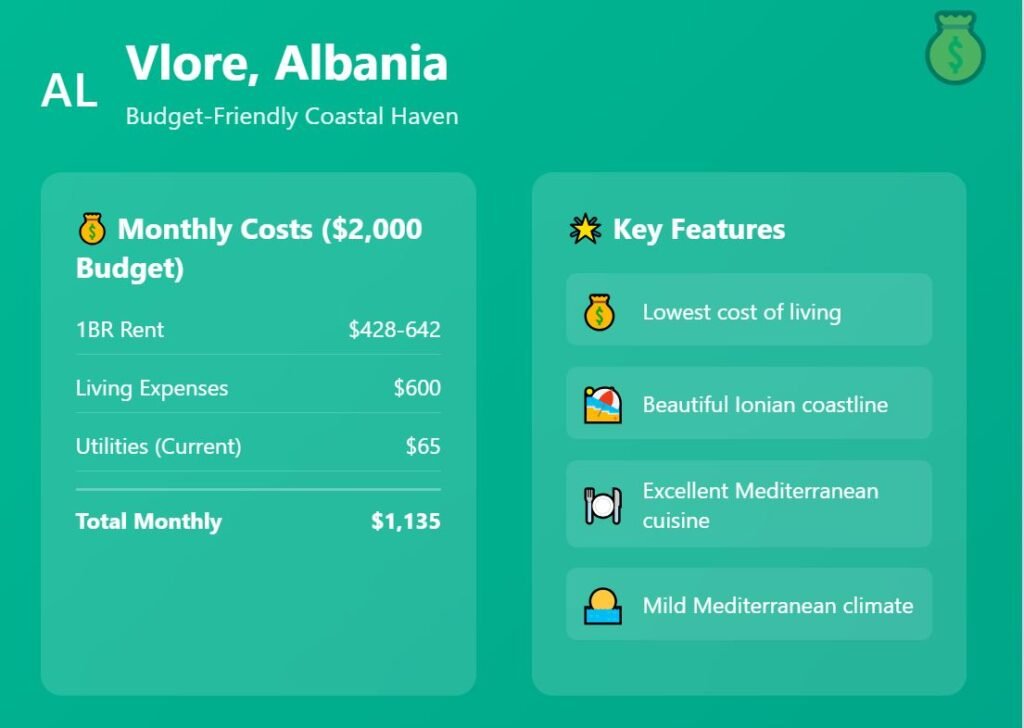
Burgas, Bulgaria, sits between these extremes. Bulgaria’s income per capita is far lower than Croatia’s, keeping prices below Split, but Burgas is still more expensive than Vlorë. Rents fluctuate with tourism but less violently than Split, giving expats milder seasonal swings. Bulgaria isn’t the cheapest, but it is consistent and delivers good quality of life and infrastructure for such prices. A good cost-benefit ratio — and that is why I covered it in a previous analysis where I talked about four places where you can live on US$1,000 or less.
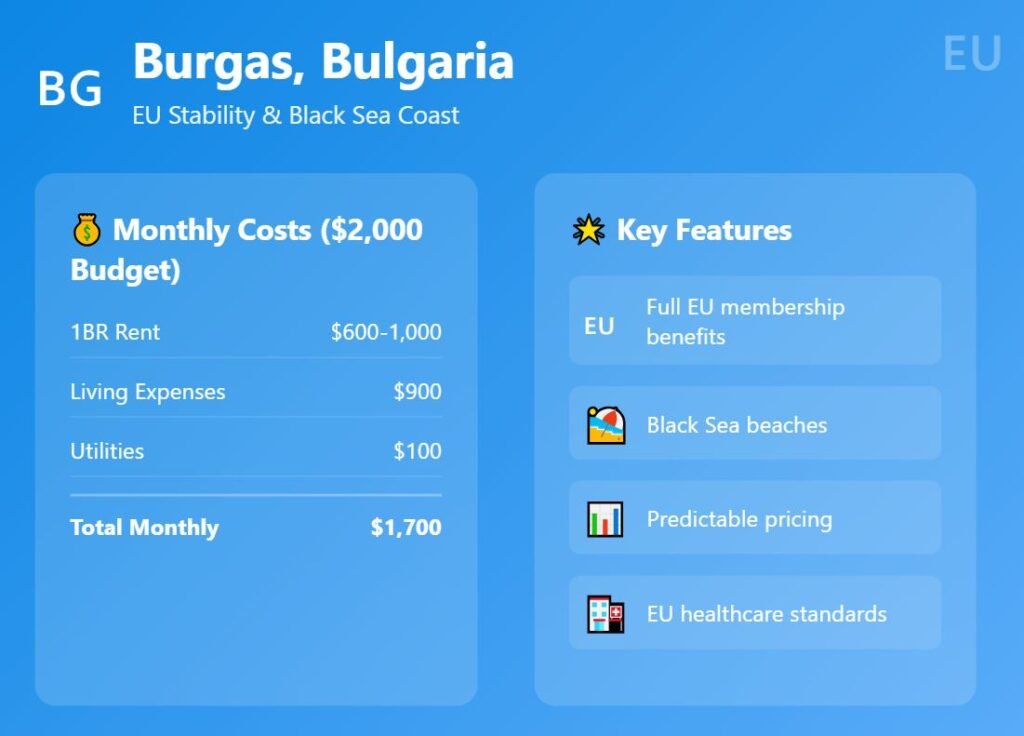
Consider now a retiree or remote worker with an income of $2,000 per month. In Vlorë, he pays manageable rent and still has substantial discretionary income. In Split, base costs near $1,200 before rent can push them into deficit, especially in peak season. Podgorica narrows the gap — $650–$900 rent is considered affordable for a budget of US$2,000. In Burgas, it is similar: $2,000 buys moderate comfort; while pricier than Albania, you would still be able to save around US$300 per month.
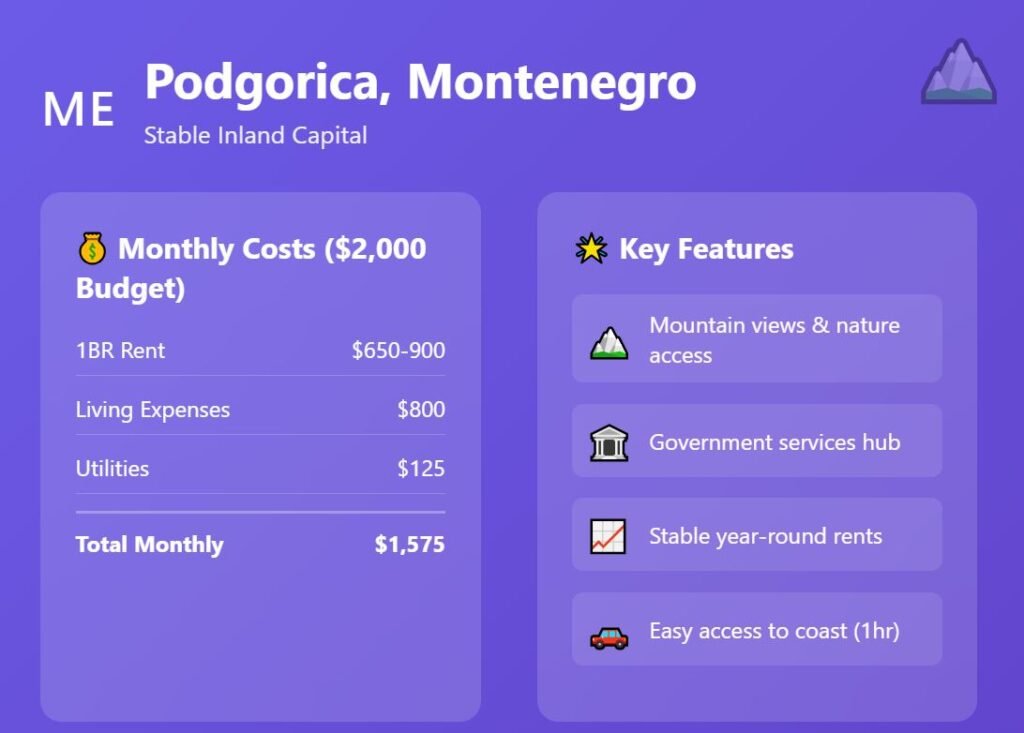
Ranking the cost of living today: Albania comes first (meaning it is the cheapest), with Vlorë offering the lowest rents and everyday prices. Montenegro is second. Bulgaria is third. And Croatia is by far the most expensive. Split strains budgets fastest, with high living costs amplified by tourist season and EU tax structures. Despite the rising costs in certain areas, many expats and locals still consider these regions among the best countries to live in Balkans due to their stunning natural beauty and rich cultural heritage. Additionally, communities in Albania and Montenegro are increasingly attracting those looking for an affordable yet vibrant lifestyle, contributing to their growing popularity among newcomers. As the demand for housing and services increases, it remains to be seen how these dynamics will further affect the cost of living in the coming years.
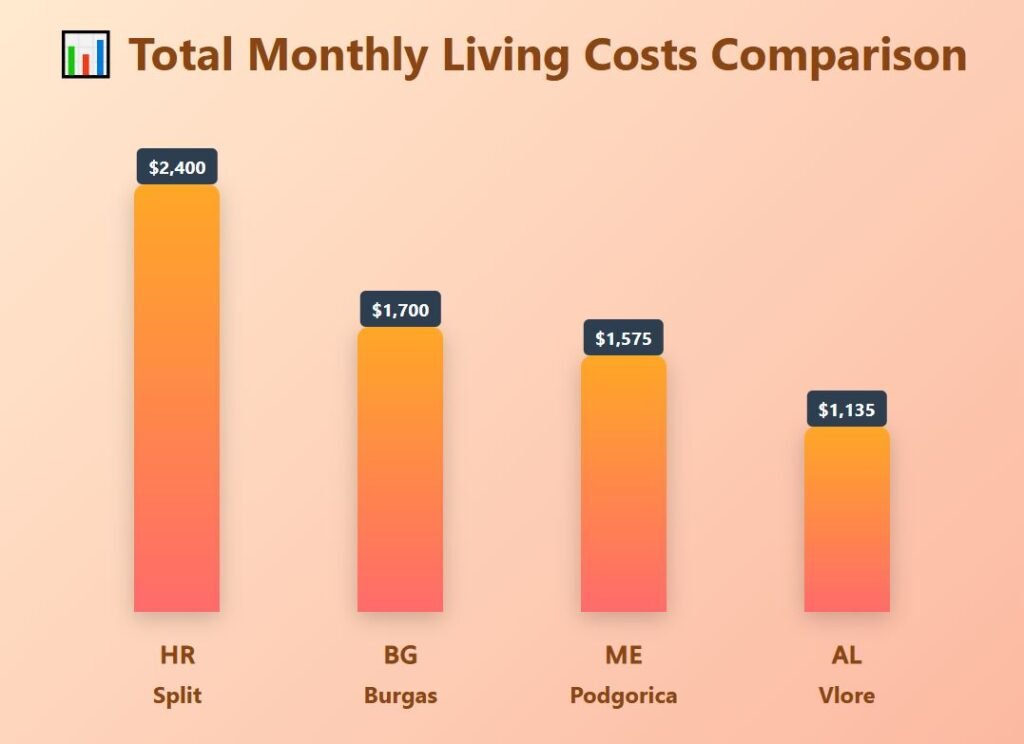
These differences show where your income stretches and where it doesn’t. And the moment we look at the next factor, the surprises are even greater…
Property Markets and the Ownership Maze
Property often becomes the trickiest part of moving abroad. Prices range from 1,284 per square meter in Vlorë to 5,885 in the best parts of Split. But headline prices tell only part of the story — ownership rules, transaction costs, and market stability matter just as much.
Croatia illustrates this clearly. Split has one of the region’s most sought-after markets, known for protecting capital rather than delivering big returns. Apartments can be purchased directly by foreigners, but land is far more restricted. Non-EU citizens need Ministry of Justice approval to buy urban plots and are barred entirely from forest and protected coastal zones.
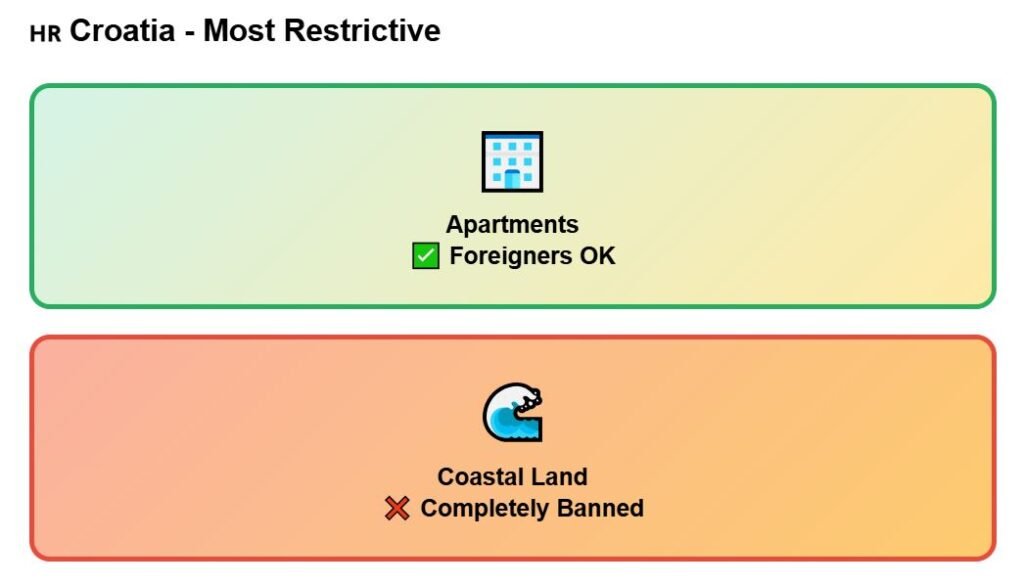
Approvals can take months, sometimes with no resolution. Add Croatia’s steep transaction costs — agent commissions, notary fees, transfer taxes, and capital gains levies — which can push closing costs up to 10%. That means a 200,000 apartment can really cost 220,000. Albania is the opposite. Entry costs are the lowest — around 1,284 per square meter in Vlorë. Laws appear open on the surface, but coastal property within 200 meters of the shore requires a locally registered company.
The larger risk is currency. Albania uses the lek as its currency, so rental income in euros can lose value by the time of sale if the lek weakens. Lifestyle buyers are drawn to low upfront costs and strong holiday rental demand, but for long-term investors seeking euro stability, risks are real.
A local told us this about real estate there:
“First and foremost, go to a lawyer (one of the big firms in town). They will take care of everything and will cost you around 500–1000, but totally worth it as you won’t have to deal with local administration, verify documents, etc.”
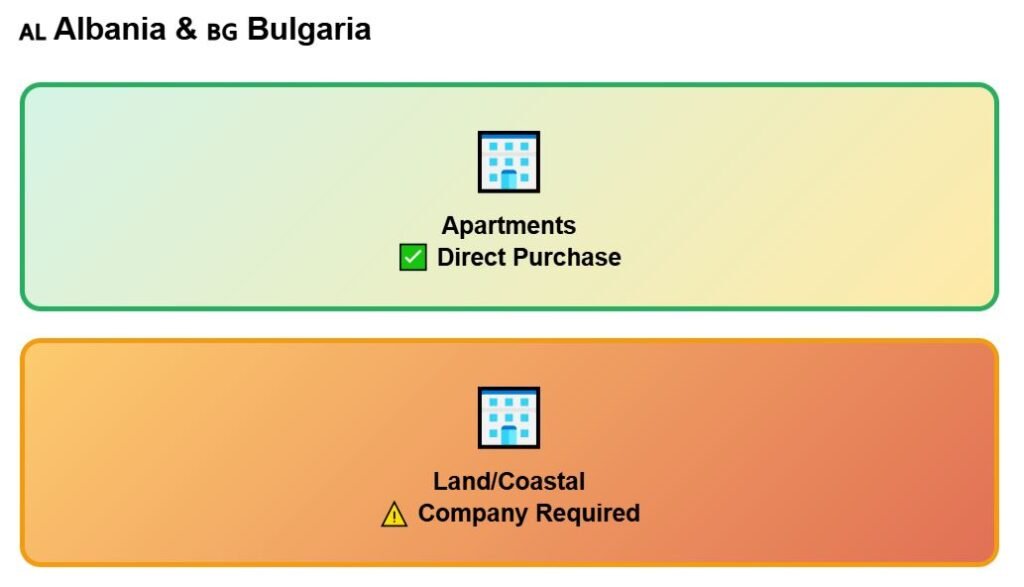
Montenegro is the most permissive legally. Podgorica allows non-EU citizens to buy apartments, houses, and urban property outright. Only agricultural land has some restrictions. More striking is performance: Montenegro recorded 20.8% annual property growth in 2024, among the highest in Europe. Forecasts expect continued growth of 3–7% annually through 2029.
Podgorica benefits from steady rental demand compared to tourist-heavy coastal areas, keeping volatility lower. Just like Montenegro, Bulgaria lies between the extremes of Croatia and Albania. In Burgas, prices sit higher than Albania’s but well below Croatia’s. Appreciation is gradual, functioning as a safer, mid-point option. Foreigners can buy apartments directly without complications. To buy land, non-EU citizens must use a company structure, similar to Albania’s coastal rules. EU/EEA citizens, however, are exempt.
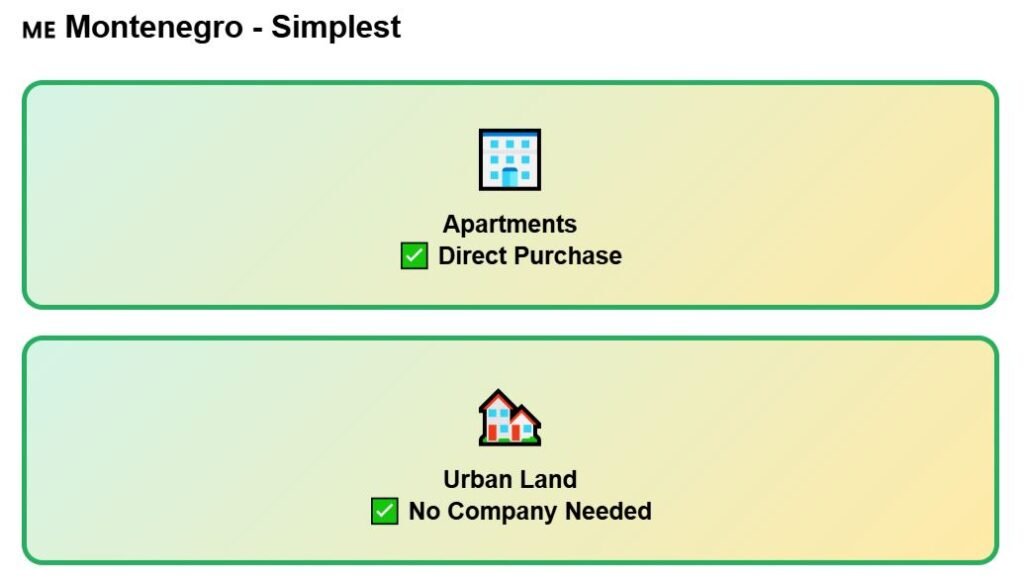
Rental prospects hinge largely on summer tourist flows along the Black Sea but without the extreme swings of Split. For cautious buyers, Burgas offers balance — transparent systems without sudden shocks. And Bulgaria has some of the most attractive real estate prices in Europe. If you’re considering buying property in any of these countries, hiring a reliable local lawyer is the safest way to protect your investment.
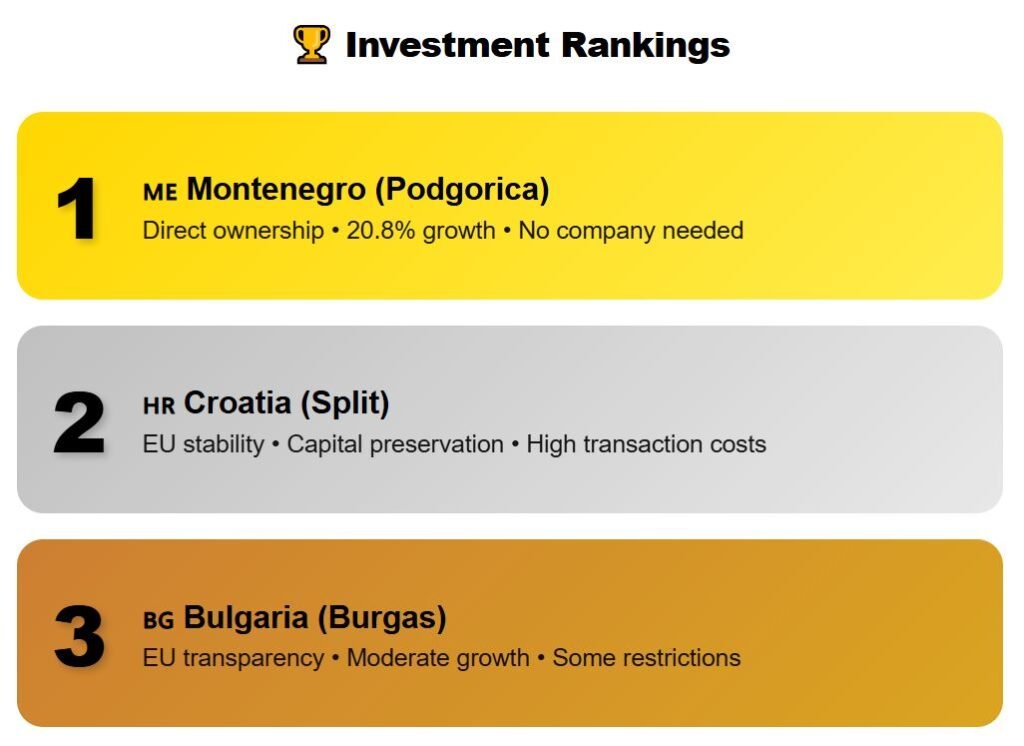
Our ranking for property opportunities and regulations is: 1st place — Montenegro: direct ownership rights and rapid growth. 2nd — Croatia: stable EU market. 3rd — Bulgaria, with a good cost-benefit ratio. Albania has the lowest entry prices, but the risks require extra caution.
Residency and Freedom of Movement
But property markets answer only half of the expat puzzle. The ability to purchase does not mean the ability to stay. And for this reason, the next factor is the one that might decide everything: how easy (or difficult) it is to obtain residency and freedom of movement.
Residency rules determine how far your life abroad can stretch — whether you’re confined to one country or gain access to an entire continent. For non-EU citizens comparing Croatia, Albania, Bulgaria, and Montenegro, the contrasts are sharp. Some programs demand high income or capital; others are accessible with modest pensions.
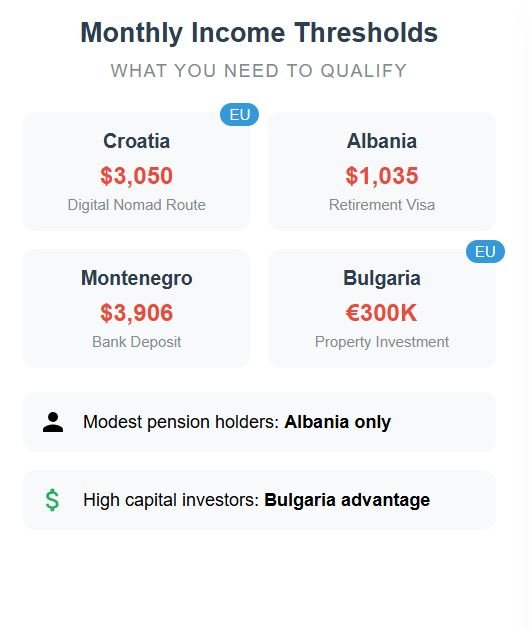
Croatia is selective. Although an EU member, its system is far from easy. The Digital Nomad Visa requires proving a monthly income of at least 2,870 per month, which is approximately $3,050. Alternative residency routes exist — temporary permits through property or employment — but renewals are rigid, and permanent residency takes years of extensions. Croatia effectively filters out applicants without high, documented income.
Meanwhile, Bulgaria has replaced its “golden visa” with more traditional residency pathways. The fast track to citizenship through investment is gone. Today, non-EU citizens can obtain long-term residence as a pensioner with sufficient income or by investing over 300,000 in property. Inside the European Union, Bulgaria has some of the most flexible and lowest thresholds for residency.
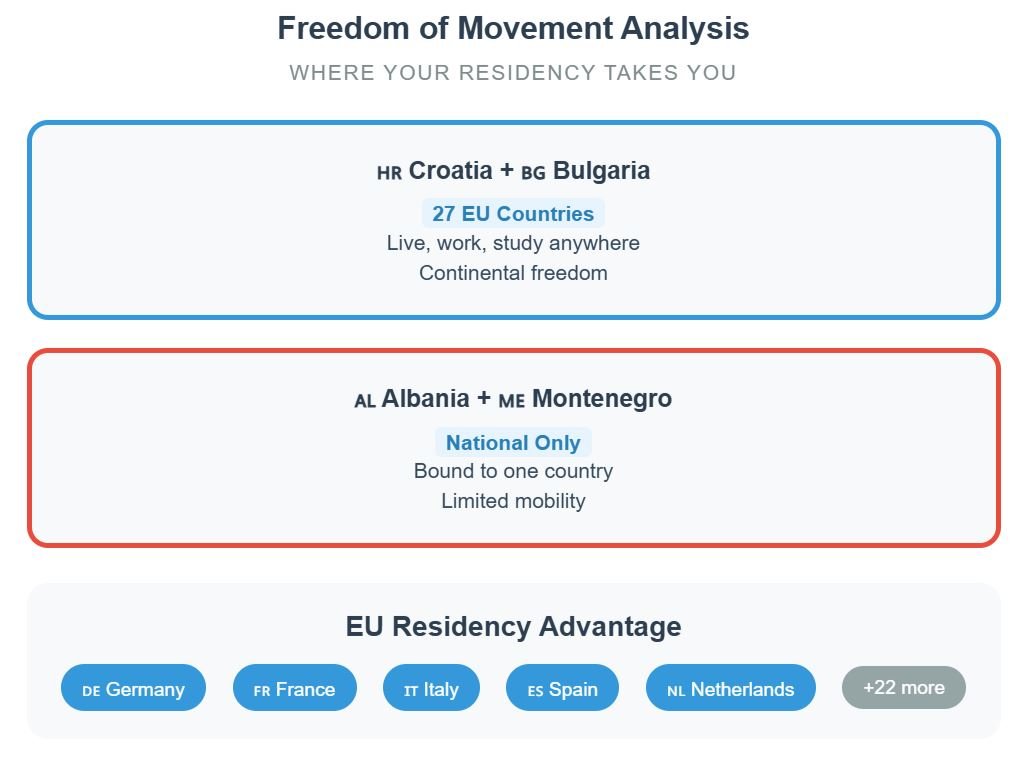
Albania instead creates accessibility through income proof rather than investment. Its retirement visa requires just $1,035 per month in pensions or steady income, one of the most attainable thresholds in Europe. Residency permits are renewed annually and can lead to permanent residency after five years. But Albanian residency doesn’t extend beyond national borders. It grants only the right to stay in Albania itself, offering no EU mobility.
For retirees or remote workers on modest pensions, it’s realistic and affordable, but limited in reach. Montenegro combines simplicity with hidden drawbacks. Residency can be obtained either by purchasing residential property or by depositing a minimum of $3,905.50 in a local bank account. On paper this looks easy — small savings or a condo suffice. There are plenty of apartments available to rent for 600 euros or less, even in the capital. But the critical detail is healthcare.

Property-based residency explicitly excludes coverage under the national healthcare system. Permit holders must purchase international private insurance that might cost thousands per year. Montenegro also offers no EU mobility through this residency, leaving expats bound to the country alone. Let’s make a direct comparison. A retiree with a $1,035/month pension qualifies smoothly for Albania but is locked out of Croatia, which gives EU access but sets much higher income hurdles. Montenegro offers quick formal residency, but be aware that you need private insurance.
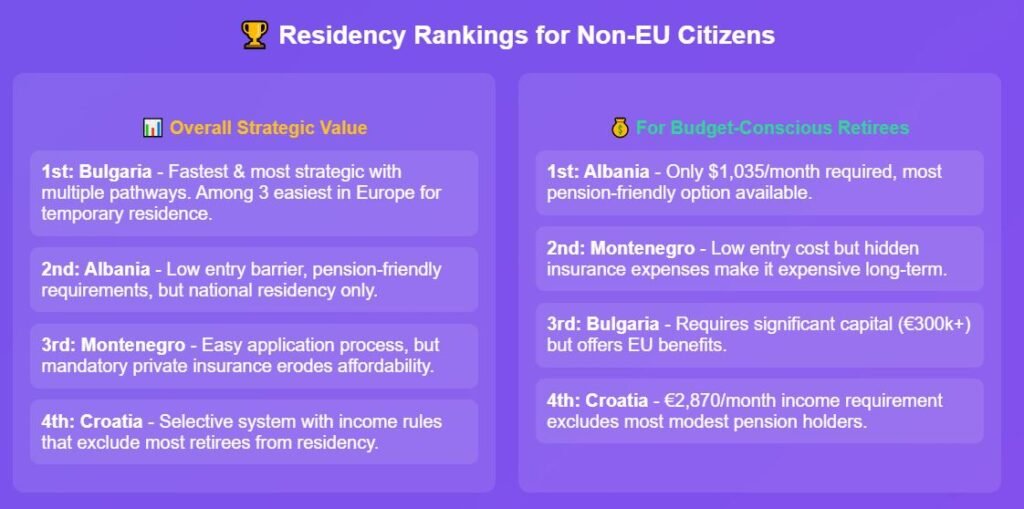
Residency ranking: 1st — Bulgaria — fastest and most strategic residency requirements, with multiple pathways. Bulgaria is among the three easiest countries in Europe to obtain temporary residence, as previously ranked. 2nd — Albania — with a low entry barrier and low requirements. 3rd — Montenegro, and in 4th is Croatia due to their stricter and higher income rules.
Final Ranking on Quality of Life and Cost of Living in the Balkans
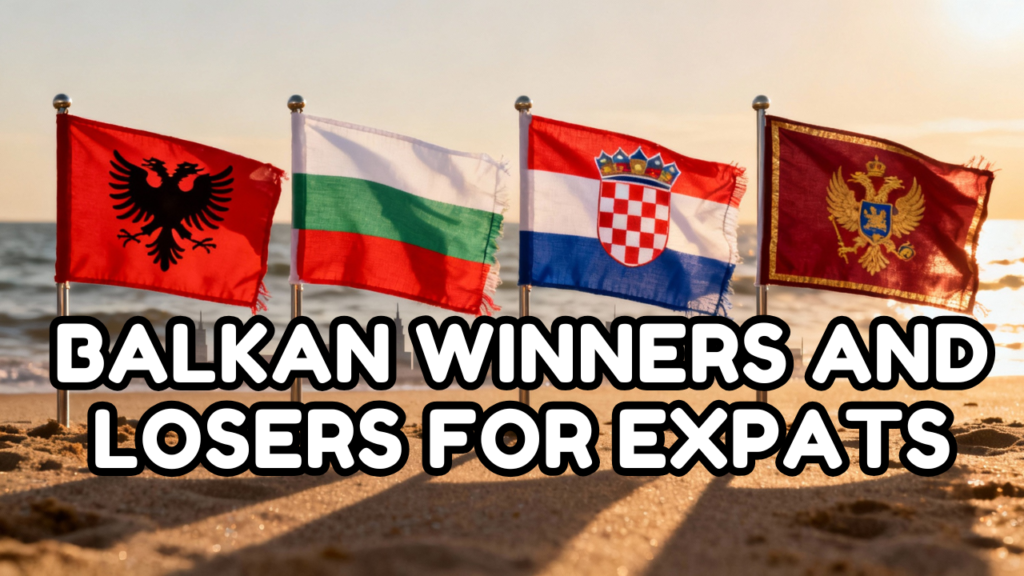
Residency is the final pillar alongside healthcare, cost of living, quality of life, and property markets. With all five categories examined, the only question left is…
Which of the four countries is the best for you?
Each country does well in one category but falls behind in another, creating distinct profiles.
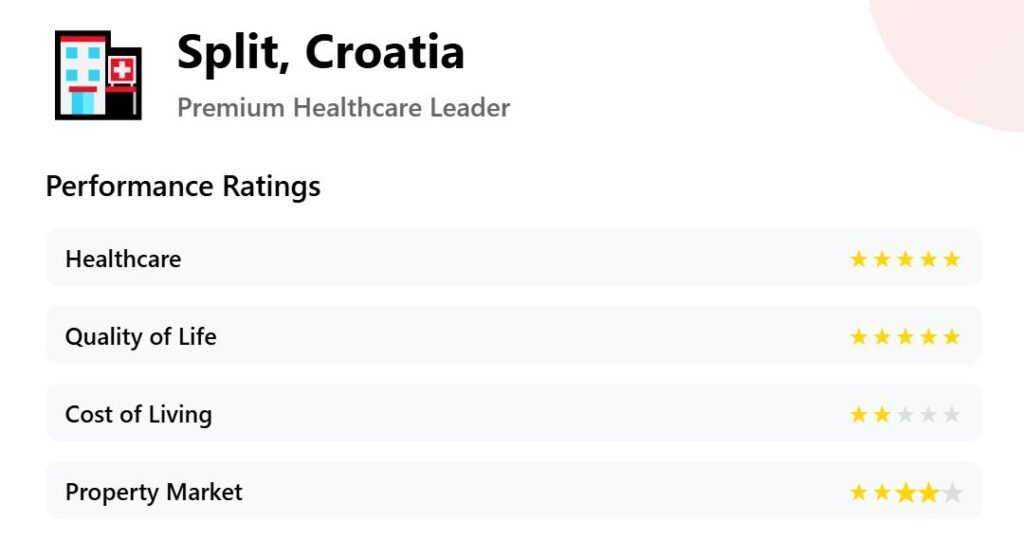
Croatia leads in healthcare and institutional quality. It has the best private healthcare and the highest HDI. But these advantages come at a steep price — the most expensive of all four places we discussed. For expats with high income or deep savings, Croatia is the premium option, but it might drain resources too quickly.
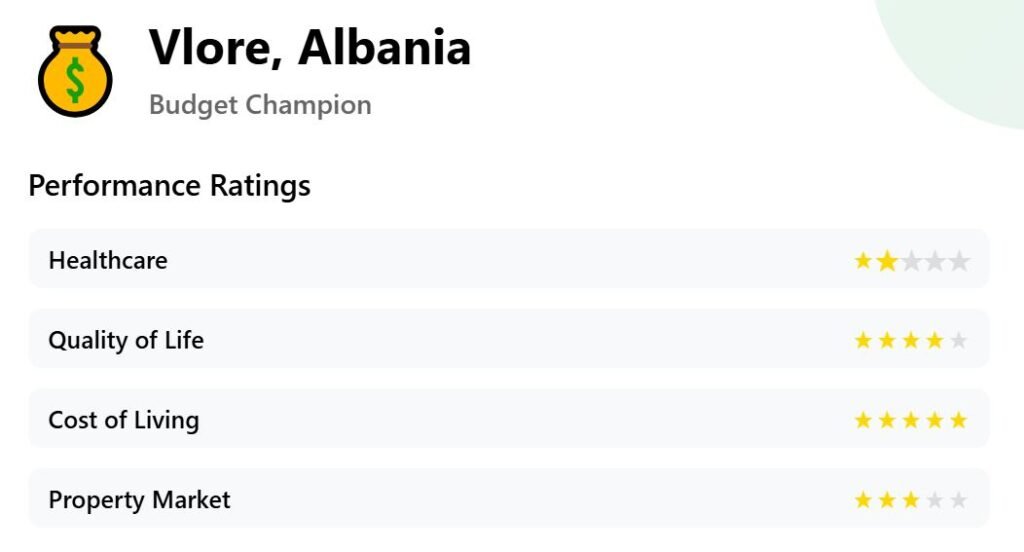
Vlorë, Albania, is the mirror opposite. It stands out for affordability — comfortable living on just $1,035/month, property entry as low as 1,284 per square meter, ultrafast internet, and the region’s highest life expectancy (79.6 years). But Albania is still a developing country, something that brings plenty of opportunities, but also more instability and worse infrastructure.
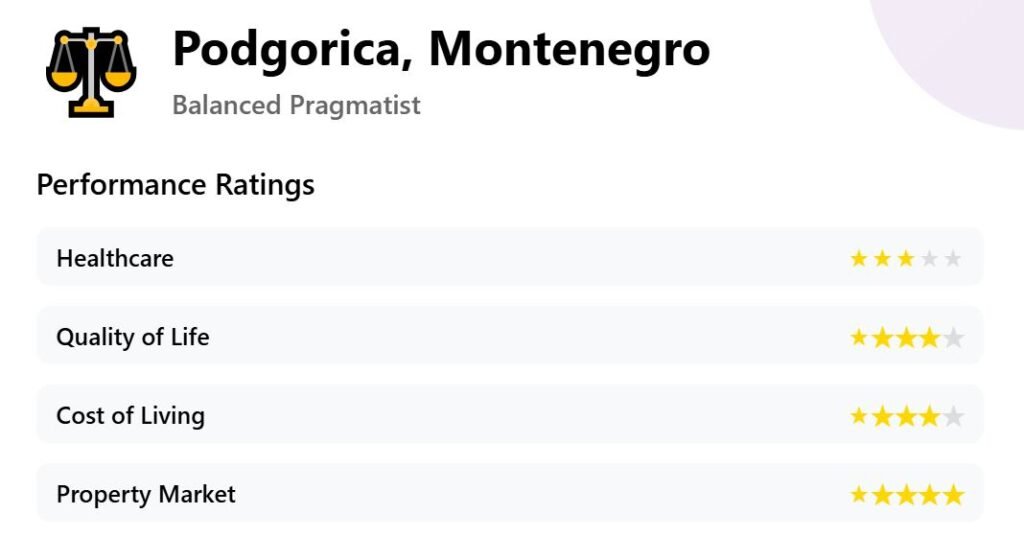
Podgorica, Montenegro, offers balance. Costs are steadier, rents less volatile. Not as cheap as Albania, not as expensive as Croatia.
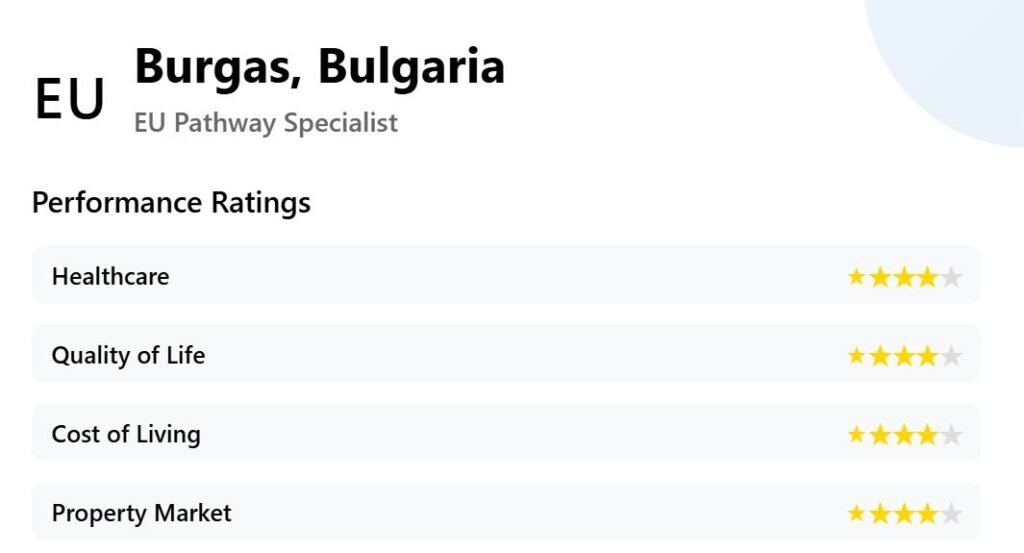
Burgas, Bulgaria, provides EU leverage and multiple paths to residency. Costs are moderate; infrastructure is decent. Property security is solid, though growth is slower than Montenegro’s.
Final comparative profiles
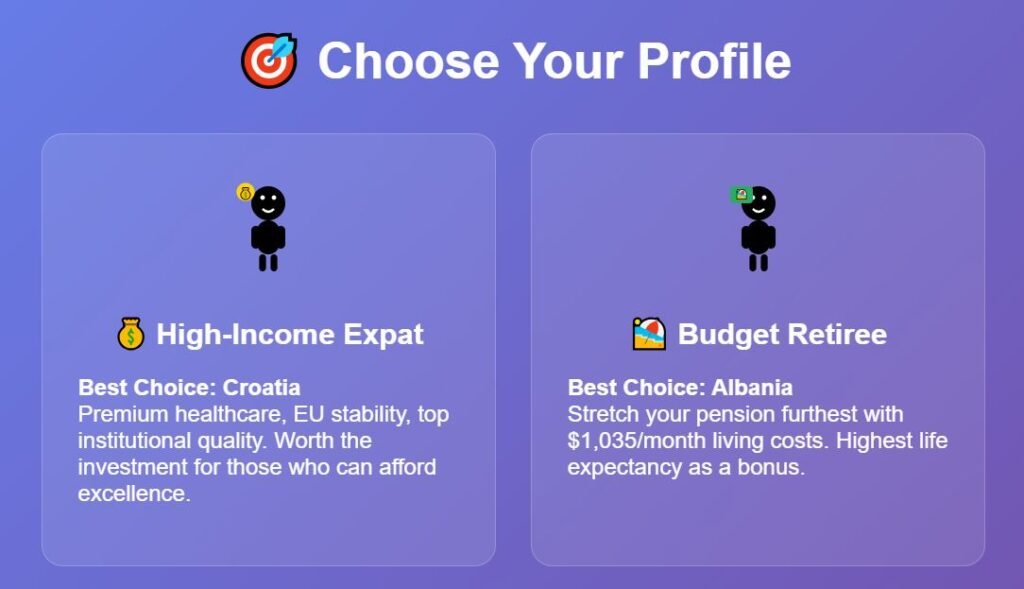
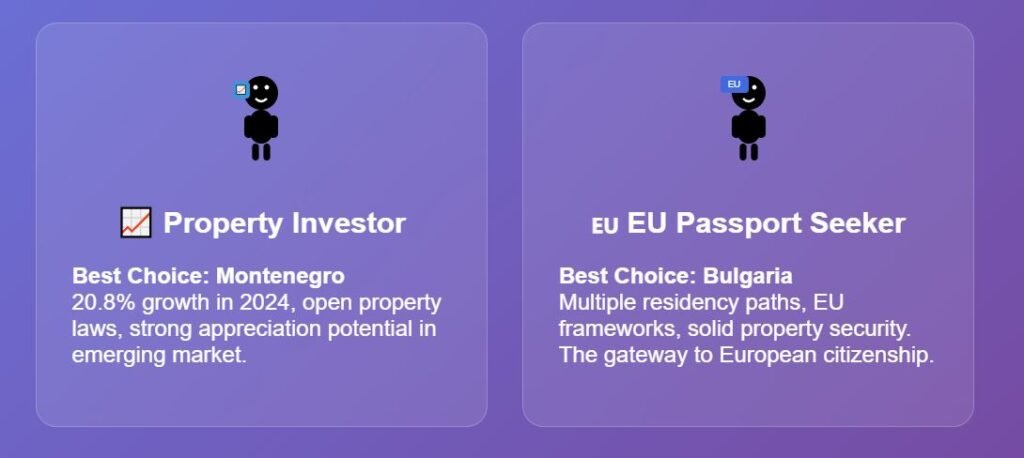
- Retirees on fixed pensions — Albania stretches dollars the furthest if you can manage the other risks.
- Those who prefer to retire in a low-cost country inside the European Union — Bulgaria.
- High-budget retirees — Croatia offers quality of life and infrastructure, but at a premium cost.
- Balanced pragmatists — Montenegro mixes affordability and growth (albeit past growth is not a guarantee of future growth).
But what if you prefer a smaller city or town where life is slower, prices are even lower, and everything looks simpler? For you, I ranked the best cities and towns to live in Europe.
Levi Borba is the founder of expatriateconsultancy.com, creator of the channel The Expat, and best-selling author. You can find him on X here. Some of the links above might be affiliated links, meaning the author earns a small commission if you make a purchase.
